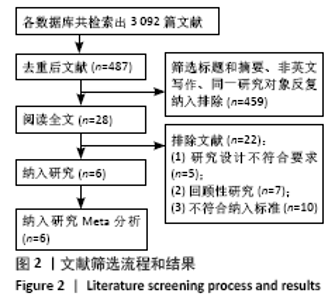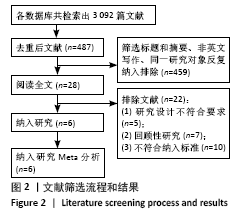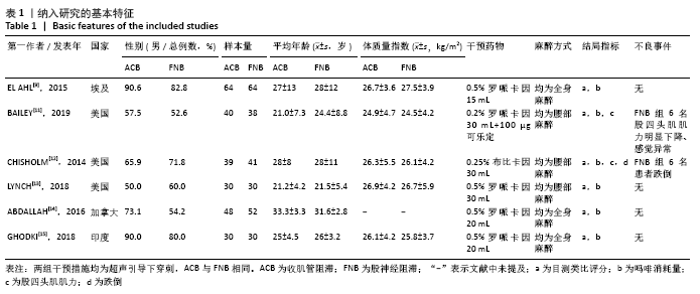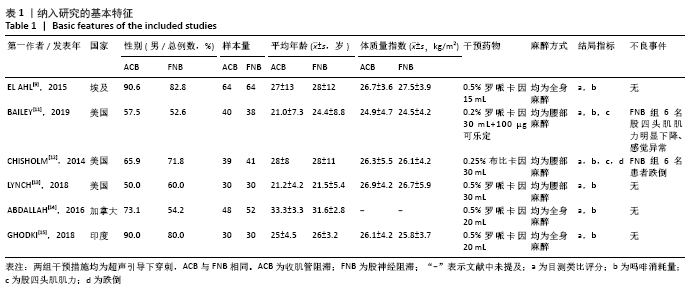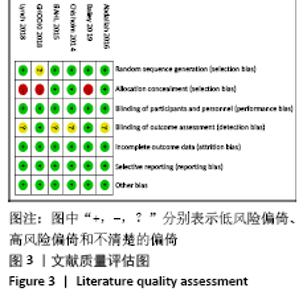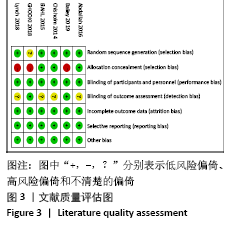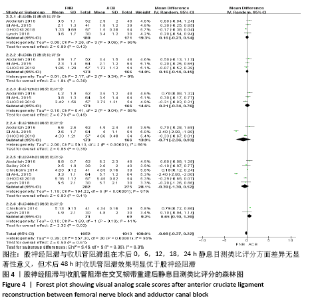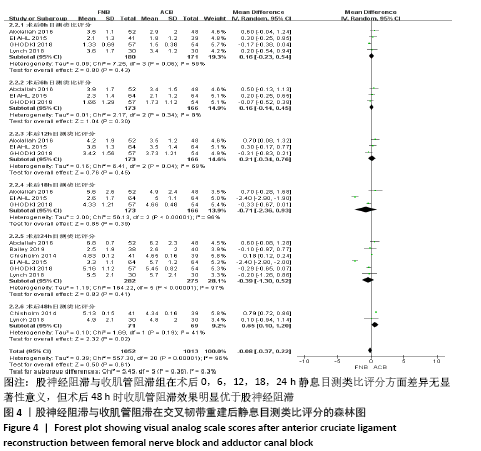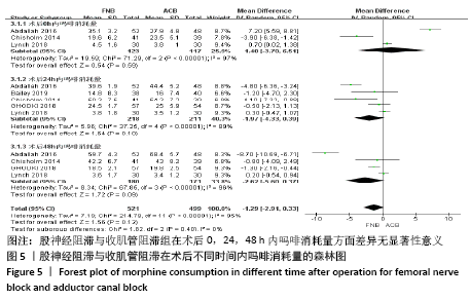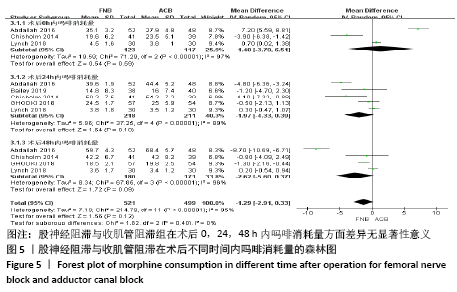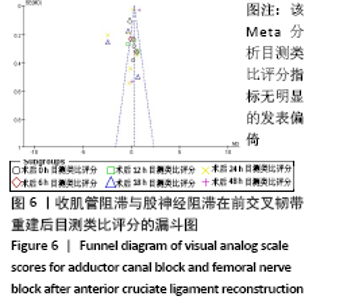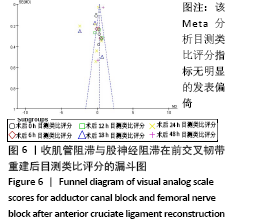Chinese Journal of Tissue Engineering Research ›› 2022, Vol. 26 ›› Issue (2): 315-320.doi: 10.12307/2022.051
Previous Articles Next Articles
Analgesic effect of adductor canal block versus femoral nerve block after autogenous bone-tendon-bone reconstruction of the anterior cruciate ligament: an updated Meta-analysis
Diao Yulei, Zong Xiaorui, Deng Zhibo, Shu Han
- Department of Orthopedics, the Second Affiliated Hospital of Chongqing Medical University, Chongqing 400010, China
-
Received:2020-11-03Revised:2020-11-06Accepted:2020-12-08Online:2022-01-18Published:2021-10-28 -
Contact:Shu Han, MD, Attending physician, Department of Orthopedics, the Second Affiliated Hospital of Chongqing Medical University, Chongqing 400010, China -
About author:Diao Yulei, Master candidate, Department of Orthopedics, the Second Affiliated Hospital of Chongqing Medical University, Chongqing 400010, China
CLC Number:
Cite this article
Diao Yulei, Zong Xiaorui, Deng Zhibo, Shu Han. Analgesic effect of adductor canal block versus femoral nerve block after autogenous bone-tendon-bone reconstruction of the anterior cruciate ligament: an updated Meta-analysis[J]. Chinese Journal of Tissue Engineering Research, 2022, 26(2): 315-320.
share this article
Add to citation manager EndNote|Reference Manager|ProCite|BibTeX|RefWorks
| [1] HALL-BURTON D, HUDSON M, GRUDZIAK J, et al. Regional anesthesia is cost-effective in preventing unanticipated hospital admission in pediatric patients having anterior cruciate ligament reconstruction. Reg Anesth Pain Med. 2016;41(4):527-531. [2] WILLIAMS B, KENTOR M, VOGT M, et al. Economics of nerve block pain management after anterior cruciate ligament reconstruction: potential hospital cost savings via associated postanesthesia care unit bypass and same-day discharge. Anesthesiology. 2004;100(3):697-706. [3] LEATHERS M, MERZ A, WONG J, et al. Trends and demographics in anterior cruciate ligament reconstruction in the United States. J Knee Surg. 2015;28(5):390-394. [4] SWANK K, DIBARTOLA A, EVERGART J, et al. The effect of femoral nerve block on quadriceps strength in anterior cruciate ligament reconstruction: a systematic review. Arthroscopy. 2017;33(5):1082-1091.e1081. [5] LUO T, ASHRAF A, DAHM D, et al. Femoral nerve block is associated with persistent strength deficits at 6 months after anterior cruciate ligament reconstruction in pediatric and adolescent patients. Am J Sports Med. 2015;43(2):331-336. [6] BURCKETT-ST LAURANT D, PENG P, GIRON ARANGO L, et al. The nerves of the adductor canal and the innervation of the knee: an anatomic study. Reg Anesth Pain Med. 2016; 41(3):321-327. [7] VORA M, NICHOLAS T, KASSEL C, et al. Adductor canal block for knee surgical procedures: review article. J Clin Anesth. 2016;35:295-303. [8] ZHAO X, JIANG N, YUAN F, et al. The comparison of adductor canal block with femoral nerve block following total knee arthroplasty: a systematic review with meta-analysis. J Anesth. 2016;30(5): 745-754. [9] El AHL MS. Femoral nerve block versus adductor canal block for postoperative pain control after anterior cruciate ligament reconstruction: a randomized controlled double blind study. Saudi J Anaesth. 2015;9(3):279-282. [10] EDWARDS MD, BETHEA JP, HUNNICUTT JL, et al. Effect of adductor canal block versus femoral nerve block on quadriceps strength, function, and postoperative pain after anterior cruciate ligament reconstruction: a systematic review of level 1 studies. Am J Sports Med. 2020;48(9): 2305-2313. [11] BAILEY L, GRIFFIN J, ELLIOTT M, et al. Adductor canal nerve versus femoral nerve blockade for pain control and quadriceps function following anterior cruciate ligament reconstruction with patellar tendon autograft: a prospective randomized trial. Arthroscopy. 2019;35(3):921-929. [12] CHISHOLM MF, BANG H, MAALOUF DB, et al. Postoperative analgesia with saphenous block appears equivalent to femoral nerve block in ACL reconstruction. HSS J. 2014;10(3):245-251. [13] LYNCH JR, OKOROHA KR, LIZZIO V, et al. Adductor canal block versus femoral nerve block for pain control after anterior cruciate ligament reconstruction: a prospective randomized trial. Am J Sports Med. 2019;47(2):355-363. [14] ABDALLAH FW, WHELAN DB, CHAN VW, et al. Adductor canal block provides noninferior analgesia and superior quadriceps strength compared with femoral nerve block in anterior cruciate ligament reconstruction. Anesthesiology. 2016;124(5):1053-1064. [15] GHODKI PS, SHALU PS, SARDESAI SP. Ultrasound-guided adductor canal block versus femoral nerve block for arthroscopic anterior cruciate ligament repair under general anesthesia. J Anaesthesiol Clin Pharmacol. 2018;34(2):242-246. [16] BOON JM, VAN WYK MJ, JORDAN D. A safe area and angle for harvesting autogenous tendons for anterior cruciate ligament reconstruction. Surg Radiol Anat. 2004;26:167-171. [17] XIE X, LIU X, CHEN Z, et al. A meta-analysis of bone-patellar tendon-bone autograft versus four-strand hamstring tendon autograft for anterior cruciate ligament reconstruction. Knee. 2015;22:100-110. [18] BENDTSEN TF, MORIGGL B, CHAN V, et al. Redefining the adductor canal block. Reg Anesth Pain Med. 2014;39:442-443. [19] BENDTSEN TF, MORIGGL B, CHAN V, et al. Defining adductor canal block. Reg Anesth Pain Med. 2014;39:253-254. [20] JAGER P, LUND J, JENSTRUP MT, et al. Reply to Dr Bendtsen. Reg Anesth Pain Med. 2014;39: 254-255. [21] BENDTSEN TF, MORIGGL B, CHAN V, et al. Basic topography of the saphenous nerve in the femoral triangle and the adductor canal. Reg Anesth Pain Med. 2015;40:391-392. [22] TUBBS RS, LOUKAS M, SHOJA MM, et al. Anatomy and potential clinical significance of the vastoadductor membrane. Surg Radiol Anat. 2007;29:569-573. [23] JAGER P, ZARIC D, FOMSGAARD JS, et al. Adductor canal block versus femoral nerve block for analgesia after total knee arthroplasty: a randomized, double-blind study. Reg Anesth Pain Med. 2013;38:526-532. [24] HEAD SJ, LEUNG RC, HACKMAN GP, et al. Ultrasound-guided saphenous nerve block–within versus distal to the adductor canal: a proof-of-principle randomized trial. Can J Anaesth. 2015;62:37-44. [25] MARIAN AA, RANGANATH Y, BAYMAN EO, et al. A comparison of 2 ultrasound-guided approaches to the saphenous nerve block: adductor canal versus distal transsartorial: a prospective, randomized, blinded, noninferiority trial. Reg Anesth Pain Med. 2015;40:623-630. [26] MARIANO ER, KIM TE, WANGER MJ, et al. A randomized comparison of proximal and distal ultrasound-guided adductor canal catheter insertion sites for knee arthroplasty. J Ultrasound Med. 2014;33:1653-1662. [27] WEI J, YANG HB, QIN JB, et al. Single-dose intra-articular bupivacaine after knee arthroscopic surgery: a meta-analysis of randomized placebo-controlled studies. Knee Surg Sports T raumatol Arthrosc. 2014;22:1517-1528. [28] BUSHNELL BD, SAKRYD G, NOONAN TJ. Hamstring donor-site block: evaluation of pain control after anterior cruciate ligament reconstruction. Arthroscopy. 2010;26:894-900. [29] FAUNø P, LUND B, CHRISTIANSEN SE, et al. Analgesic effect of hamstring block after anterior cruciate ligament reconstruction compared with placebo: a prospective randomized trial. Arthroscopy. 2015;31:63-68. [30] WILLIAMS BA, BOTTEGAL MT, KENTOR ML, et al. Rebound pain scores as a function of femoral nerve block duration after anterior cruciate ligament reconstruction: retrospective analysis of a prospective, randomized clinical trial. Reg Anesth Pain Med. 2007;32:186-192. |
| [1] | Jing Jinpeng, Zhang Yue, Liu Xiaomin, Liu Yi. Traditional Chinese medicine injection for promoting blood circulation in prevention of deep vein thrombosis after orthopedic surgery: network meta-analysis [J]. Chinese Journal of Tissue Engineering Research, 2022, 26(9): 1467-1476. |
| [2] | Wu Min, Zhang Yeting, Wang Lu, Wang Junwei, Jin Yu, Shan Jixin, Bai Bingyi, Yuan Qiongjia. Effect of concurrent training sequences on body composition and hormone response: a Meta-analysis [J]. Chinese Journal of Tissue Engineering Research, 2022, 26(8): 1305-1312. |
| [3] | Kan Houming, Fan Lijun, Chen Xuetai, Shen Wen. Application of platelet-rich plasma in neuropathic pain [J]. Chinese Journal of Tissue Engineering Research, 2022, 26(8): 1286-1292. |
| [4] | Wu Bingshuang, Wang Zhi, Tang Yi, Tang Xiaoyu, Li Qi. Anterior cruciate ligament reconstruction: from enthesis to tendon-to-bone healing [J]. Chinese Journal of Tissue Engineering Research, 2022, 26(8): 1293-1298. |
| [5] | Liu Gang, Ma Chao, Wang Le, Zeng Jie, Jiao Yong, Zhao Yi, Ren Jingpei, Hu Chuanyu, Xu Lin, Mu Xiaohong. Ankle-foot orthoses improve motor function of children with cerebral palsy: a Meta-analysis based on 12 randomized controlled trials [J]. Chinese Journal of Tissue Engineering Research, 2022, 26(8): 1299-1304. |
| [6] | Gao Yujin, Peng Shuanglin, Ma Zhichao, Lu Shi, Cao Huayue, Wang Lang, Xiao Jingang. Osteogenic ability of adipose stem cells in diabetic osteoporosis mice [J]. Chinese Journal of Tissue Engineering Research, 2022, 26(7): 999-1004. |
| [7] | Wu Weiyue, Guo Xiaodong, Bao Chongyun. Application of engineered exosomes in bone repair and regeneration [J]. Chinese Journal of Tissue Engineering Research, 2022, 26(7): 1102-1106. |
| [8] | Zhou Hongqin, Wu Dandan, Yang Kun, Liu Qi. Exosomes that deliver specific miRNAs can regulate osteogenesis and promote angiogenesis [J]. Chinese Journal of Tissue Engineering Research, 2022, 26(7): 1107-1112. |
| [9] | Yang Kuangyang, Wang Changbing. MRI evaluation of graft maturity and knee function after anterior cruciate ligament reconstruction with autogenous bone-patellar tendon-bone and quadriceps tendon [J]. Chinese Journal of Tissue Engineering Research, 2022, 26(6): 963-968. |
| [10] | Li Jie, Zhang Haitao, Chen Jinlun, Ye Pengcheng, Zhang Hua, Zhou Bengen, Zhao Changqing, Sun Youqiang, Chen Jianfa, Xiang Xiaobing, Zeng Yirong. Anterior cruciate ligament rupture and patellofemoral joint stability before sagittal and axial measurement using MRI [J]. Chinese Journal of Tissue Engineering Research, 2022, 26(6): 969-972. |
| [11] | Zhou Jianguo, Liu Shiwei, Yuan Changhong, Bi Shengrong, Yang Guoping, Hu Weiquan, Liu Hui, Qian Rui. Total knee arthroplasty with posterior cruciate ligament retaining prosthesis in the treatment of knee osteoarthritis with knee valgus deformity [J]. Chinese Journal of Tissue Engineering Research, 2022, 26(6): 892-897. |
| [12] | He Junjun, Huang Zeling, Hong Zhenqiang. Interventional effect of Yanghe Decoction on synovial inflammation in a rabbit model of early knee osteoarthritis [J]. Chinese Journal of Tissue Engineering Research, 2022, 26(5): 694-699. |
| [13] | Liu Yiyi, Qiu Junqiang, Yi Longyan, Zhou Cailiang. Effect of resistance training on interleukin-6 and C-reactive protein in middle-age and elderly people: a Meta-analysis [J]. Chinese Journal of Tissue Engineering Research, 2022, 26(5): 804-812. |
| [14] | Wang Nan, Qian Yuzhang, Xie Lin. Network Meta-analysis of different acupuncture methods for the treatment of lumbar disc herniation [J]. Chinese Journal of Tissue Engineering Research, 2022, 26(5): 813-820. |
| [15] | Lu Qinxue, Xu Ning, Yang Yinglan, Han Qianqian, Duanmu Xianyu, Guo Yuwei, Han Qing. Femoroacetabular impingement: strength trainings for nerve-muscle, peripheral muscle and core muscle [J]. Chinese Journal of Tissue Engineering Research, 2022, 26(5): 786-791. |
| Viewed | ||||||
|
Full text |
|
|||||
|
Abstract |
|
|||||
